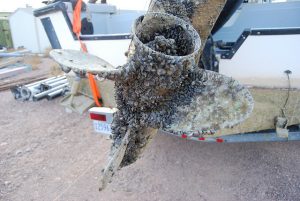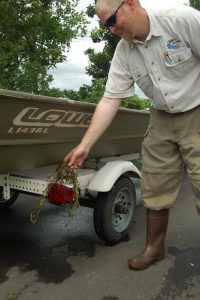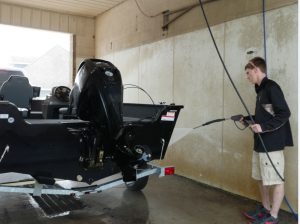The Stop Aquatic Hitchhikers! campaign is a call to action that empowers recreational users of aquatic resources in the United States and other countries to help stop the spread of harmful aquatic invasive species through outreach and partnerships.
You can help by taking the following actions:
The Stop Aquatic Hitchhikers! values are the basis for this campaign. These statements are what the U.S. Fish and Wildlife Service and our partners believe in. The values serve as the foundation to empower recreational users of aquatic resources to help stop the spread of harmful aquatic invasive species through outreach, education and partnerships.
The Stop Aquatic Hitchhikers! national education campaign was launched by the Aquatic Nuisance Species Task Force in 2002. It is designed to raise awareness about aquatic invasive species and empower people who recreate on the water to become part of the solution in preventing the spread of these harmful species.
Prior to Stop Aquatic Hitchhikers!, most outreach efforts focused on raising awareness about specific invasive species. As the list of invasive species continued to grow, this approach became problematic and created confusion as the species specific outreach materials often required different prevention instructions. There was a clear need for consistent and comprehensive prevention guidance. Stop Aquatic Hitchhikers! was developed to meet this need Being more than just a motto, the campaign is a catalyst for community-based conservation that promotes 21st century stewardship with a clear call to action.
By working through the Task Force, the U.S. Fish and Wildlife Service branded the campaign and its prevention behaviors, creating a grassroots branding strategy that has helped to spread the word. In 2017, the Fish and Wildlife Service has refreshed the campaign by creating a new website, updating the tag lines, and creating new co-branding capabilities. Currently, there is network of over 1,400 campaign partners across the country that includes federal, state, tribe, and local agencies, colleges and universities, municipalities, townships, watershed districts, K – 12 school groups, businesses, media, non-profits, fishing tournaments, clubs and other organizations.
When a community wants to elevate awareness about the newest invasive species, they can co-brand their efforts with Stop Aquatic Hitchhikers! and receive the benefits of 15 years of outreach experience. The campaign was designed to promote a unified message, it is available to everyone – and it is free. Please consider the benefits Stop Aquatic Hitchhikers! can bring to your local water and join us. By joining, you will gain access to customizable campaign materials that allow you and your organization to promote the Clean, Drain, Dry prevention materials. The number and diversity of campaign partners is evidence of the value and benefit from joining the campaign. Let the partnership help you… Please contact us at info@stopaquatichitchhikers.org, if you have any questions.
Clean Drain Dry is the primary message of the Stop Aquatic Hitchhikers! campaign, as it conveys a simple and effective procedure for recreational users to follow:
CLEAN off visible aquatic plants, animals, and mud from all equipment before leaving water access
DRAIN watercraft bilge, livewell, motor and other water containing devices before leaving water access.
DRY everything for at least five days OR wipe with a towel before reuse.
For ANGLERS, the additional step of DISPOSE is recommended:
DISPOSE of unwanted bait, worms, and fish parts in the trash. When keeping live bait, drain bait containers and replace with spring or dechlorinated tap water. Never dump live fish or other organisms from one water body into another.
Get detailed information about the Clean Drain Dry procedure, including instructions for specific recreational activities.
Aquatic invasive species are organisms that live within inland, estuarine, or marine waters, have been spread to locations where they do not naturally occur, and cause economic or environmental harm or harm to human health. In addition, they negatively impact the quality of outdoor recreation experiences. Invasive species may also be called exotic, alien, nonindigenous, nuisance, or hitchhiker. Learn the difference between these terms and how they relate to one another.

Aquatic Hitchhikers are aquatic invasive species that can be transported to other waterbodies by recreational activities.
Aquatic Hitchhikers are aquatic invasive species that can be transported to other waterbodies by recreational and other activities.
The spread of aquatic invasive species is a global problem causing habitat destruction, species extinction, loss of biological diversity, impaired recreation, and even loss of human lives. Aquatic invasive species threaten our environment, economy, and safety. In addition, they negatively impact the quality of outdoor recreation experiences. Learn more about the harm of aquatic invasive species.
Species can be moved to new locations in many different ways and most are a result of human activity. Common pathways of aquatic invasive species include:

Some aquatic invasive species (e.g., zebra mussels) can attach to boats, while others (e.g., aquatic plants) can cling or get tangled on propellers, anchor lines, and boat trailers. Many species can survive in bilge water, ballast tanks, and motors. Aquatic invasive species can hide in the mud, dirt, and sand that cling to nets, buckets, anchors, and waders. Some organisms many even be unknowingly released with the dumping of bait. Remember – all recreational activities have the potential to spread aquatic invasive species!
Learn to identify aquatic invasive species. Inform family and friends. If you find a retailer selling something that is prohibited, inform them of the issue. Report new sightings of aquatic invasive species to the appropriate authorities or use the USGS Online Sighting Report Form. Your actions are vital to prevent the spread of aquatic invasive species.
Each time you visit a waterbody, you have the opportunity to prevent further spread of aquatic invasive species. Most species can be stopped by following the Clean Drain Dry procedure before leaving a water access:
CLEAN off visible aquatic plants, animals, and mud from all equipment before leaving water access

DRAIN motor, bilge, livewell, and other water containing devices before leaving water access.
DRY everything for at least five days OR wipe with a towel before reuse.
If you are an angler, also:
DISPOSE of unwanted bait, worms, and fish parts in the trash. When keeping live bait, drain bait containers and replace with spring or dechlorinated tap water. Never dump live fish or other organisms from one water body into another.
Clean, Drain, Dry is a simple three step process that boaters can follow every time they move from one body of water to another. When boaters take action every time they leave the water, they can stop the spread of harmful aquatic invasive species!
Cleaning removes visible plants, mud, and large-bodied organisms that are attached to, or in, watercraft, trailers, or recreational equipment. Draining removes water which hides small and nearly invisible invasive organisms such as zebra mussel larvae (veligers). Drying is necessary to ensure that living biological material is not being moved, as many organisms can survive in small amounts of standing water. Together, these three steps are effective at preventing the spread of aquatic invasive species.
Research indicates that 140°F water will kill most aquatic invasive species. However, residential hot water heaters are generally set at 120°F, and temperatures at the nozzle will be lower because of the water’s heat loss to pipes, hoses, ambient temperature, etc. Likewise, commercial car washes rarely have water hotter than 100°F. For these reasons, 140°F water is likely unobtainable; however, individuals can maximize their decontamination efficacy by using water that’s as hot as possible. Skin contact should be avoided when using water above 120°F to avoid irritation or burns. In the absence of hot water (or high pressure), removing all visible material, rinsing with tap water, and completely drying will help prevent spread of aquatic invasive species.
Drying times vary significantly depending upon the type of equipment, air temperature, and relative humidity. While the outside of a boat will dry relatively rapidly, the bilge, live wells, and other areas of a boat not reached by the sun or lacking good air circulation will take additional time to dry. At least 5 days drying time in dry, warm conditions is recommended. However, the key is to make certain that equipment is COMPLETELY dry before using it in a new water body. If the recommended dry time cannot be achieved, wiping all areas with a towel will help prevent spread of aquatic invasive species.
Restricting your activities to one particular waterbody certainly reduces the chance of spreading aquatic invasive species. However, the tools and guidelines of this campaign will help protect your favorite fishing or boating spot by ensuring that you do not introduce any new species into the area. When angling, make sure that you properly dispose of all bait and do not dump it into the water. If you borrow equipment, clean it before you use it. Most importantly, inform others about this campaign and make sure they follow the Clean Drain Dry steps before entering and after leaving the water.
The longer an object boat sits in infested waters, the greater the chance aquatic invasive species can attach. Accordingly, for boats or other recreational equipment that have been left in the water for more than a day, the following decontamination methods are recommended in accordance with manufacturers’ recommendations:
The Stop Aquatic Hitchhikers web site is part of the ANS Task Force public awareness campaign and is sponsored by the U.S. Fish and Wildlife Service.